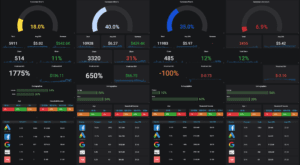Google Analytics (GA) and Google Tag Manager (GTM) allow you to track website activity including how many people visited your site, what they looked at, which pages convert (if set up correctly), and which pages abandon.
Here's a summary of how Google Analytics and Tag Manager work and some of the key metrics that they calculate.
First, installing GA is a very simple process. You create a free account at https://google.com/analytics and create a website property, then Google provides a script that is copied and pasted into your website pages. For people using website builders such as WordPress or WIX, You often can find a plug-in where you just enter in the tracking code and GA inserts code onto your webpage that sends the following information to Google’s servers for analysis:
Audience Overview
The Audience Overview tracks summary information on how many users access your site.
Users: the number of unique devices that have visited your site
Sessions: the number of times a user visited your site during a 30 minute time span. For example, if A user goes to your website, sits on a page for 30 minutes, that is tracked is one session. If at minute 31 they refresh the page or go to another page, that is tracked as a second session.
Bounce rate: a person who only views a single page on your website during the session timeframe pages/session: how many pages were visited during Session
Average Session Duration: How long the visitor viewed your website (note that last page visited isn’t included in the session metrics.)
Page views: the number of pages visited on your website
Unique Pageviews: number of Sessions that viewed a page. Ie. A person who visits the same page twice during a 30 minute session would be counted as to page Views and one unique page view
Active users: number of users who have accessed your site within the past five minutes.
GTM allows you to add custom code to your website to track specific actions such as conversions, pipeline status and others. If set up correctly, you can track ROI on your campaigns. To implement GTM correctly, you should work with a developer.
This article has some of the best steps we’ve found for implementing Google Tag Manager
GTM allows you to get more detailed analysis of your data but requires a lot of work to set up and configure to get full use of the platform. GTM has a couple options for setup:
Track Page Views: Tracks each page viewed or specific page views
Track Click Events: Tracks links clicked on your site to other URLs (i.e. links to social media sites or live chat clicks)
Track Scroll Depth: Track how far a user went on your website which is important for content that is frequently viewed on mobile devices or to identify if users are seeing critical content below the fold
Track Form Submissions: Track when a user submits a form
Track History: Typically used for single page applications (websites that look like they have multiple pages, but instead use a framework that renders all pages at once) to track ‘virtual page views’ in an app (also known as virtual pageviews.)
Track Video Views: Tracks time user watched a video on your website
Track over Time (Timed Intervals): Track over intervals – this helps to get more accurate session information for the user
Track Custom Events: This enables you to track specific actions a customer took on your website and create custom tracking for reporting (i.e. viewed a specific page, added to cart, checked out successfully). This is the only way to track website activity to a specific user for analysis.
Both GA/GTM provide powerful information to organizations looking to optimize their marketing and websites to attract customers. Both of these tools, however, have their limitations and challenges. See our article Pros and Cons to Using Google Analytics and Tag Manager for more info about what to consider when you implement these solutions for your company.








